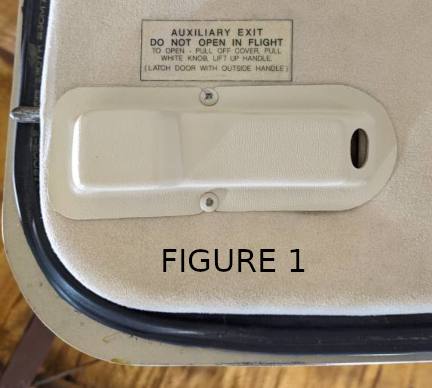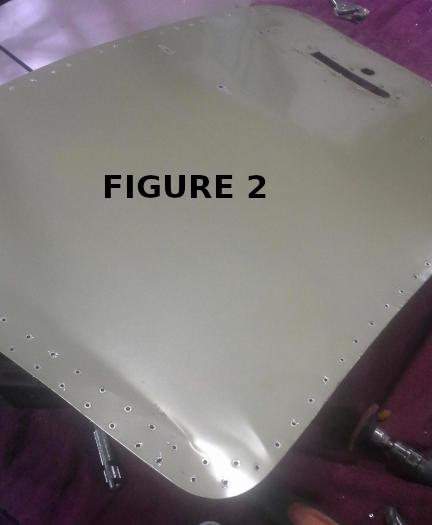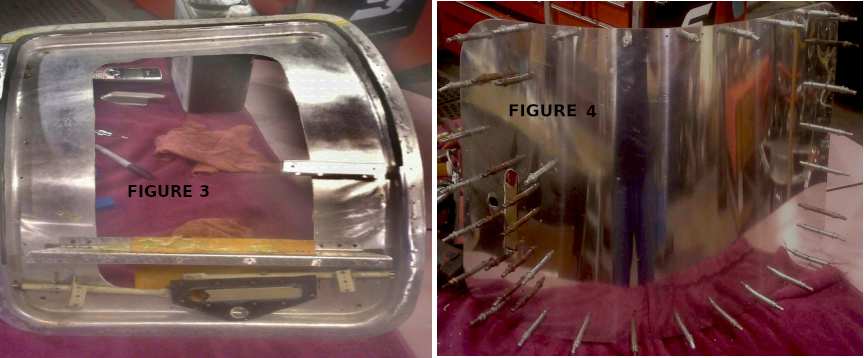Mooney Baggage Door Repair
ShopTalk - December 2021
This month’s ShopTalk will bring the reader into the world of repairing a damaged baggage door, but first a little history.
In 1978, Mooney stopped producing airplanes with only an outside baggage door latch. The earlier baggage doors could only be opened from outside leaving only one egress point, the main cabin door. This single outside latch was very reliable and it was rare to have a baggage door open at rotation or in flight. Unfortunately, if you crashed into the trees and the inboard right wing root was pushed in, it could foul the cabin door and make an emergency egress impossible. It is very difficult to push out the windshield or break out any side window, especially if you are injured.
In 1978, Mooney reconsidered this issue and changed the baggage door latch system. Here is a link (opens in a new window) to the pertinent Service Bulletin M20-239A. Now, the door can be opened from the inside using an emergency latch handle mounted on the inside of the baggage door using a safety pin/clip on a lanyard. This is protected by a plastic cover attached to the interior door panel with 2 small screws. See Figure 1.
This plastic cover has a hole in it, so one can place their finger in the hole and rip the cover off, not needing a screwdriver. Once the cover is removed, the latch safety pin can be removed and the inside lever lifted up, thus releasing the outside lever and the fore & aft pins that secure the baggage door closed.
Unfortunately, the outside lever to open the baggage door was also changed by becoming flush mounted. This looks nice, but low pressure forming over the latch area at rotation can cause the lever (if worn, loose and unlocked) to lift just enough to open the baggage door.
The baggage door can and should be locked before start up and, in case of an emergency, still be opened from the inside. This solves the possibility of the door opening at rotation, but this is not addressed in the Mooney Aircraft Flight Manual (AFM/POH). The POH (Preflight section) just says to make sure the door is secured. Service Bulletin M20-239A requires an AFM Supplement and under SECTION II - LIMITATIONS requires a new placard inside on the baggage door which states "LOCK DOOR" as the last step when the door has been opened from the inside. This is the only place locking the door is mentioned. Many Mooney pilots do not know this little tidbit of info, and for those of you that think a rescue team can’t get you out because of a locked door, trust me, this lock won't stop them from getting you out.
 If the door opens at rotation, the plane can still be flown normally, but the sudden wind noise and objects flying out will cause a distraction at a very important time in one’s flight. This distraction could lead to an accident if the pilot forgets that #1 rule, always fly the plane first.
If the door opens at rotation, the plane can still be flown normally, but the sudden wind noise and objects flying out will cause a distraction at a very important time in one’s flight. This distraction could lead to an accident if the pilot forgets that #1 rule, always fly the plane first.
When the door opens, it will travel until the retractable bar that is attached to the airframe and baggage door meets it’s travel limits. Normally this bar will hold, but the bending moment on the door will deform the outside skin and the door frame. This can be seen in Figure 2. In severe cases, the cabin roof skin will also deform ajacent to the baggage door hinge.
So what is involved in repairing a bent baggage door? The first thing is to remove the baggage door leaving the hinge riveted to the airframe (assuming it is not damaged). Next, remove the door seal, then all the rivets that hold the outer skin to the baggage door. Save this skin as it will make a good pattern for the replacement skin.
Once the outer skin is off, straighten the door frame (Figure 3) and fit it back on the airplane to make sure your straightening is correct. The baggage door skin is thin (0.025”) and can be duplicated with a piece of 2024T3 025 alclad aircraft aluminum. Using the undamaged portion of the original skin, one can get 90 percent of the pattern of the original skin fabricated and fit (Figure 4). The remaining 10 percent is done with the door mounted to the airframe.
In 1978, Mooney stopped producing airplanes with only an outside baggage door latch. The earlier baggage doors could only be opened from outside leaving only one egress point, the main cabin door. This single outside latch was very reliable and it was rare to have a baggage door open at rotation or in flight. Unfortunately, if you crashed into the trees and the inboard right wing root was pushed in, it could foul the cabin door and make an emergency egress impossible. It is very difficult to push out the windshield or break out any side window, especially if you are injured.
In 1978, Mooney reconsidered this issue and changed the baggage door latch system. Here is a link (opens in a new window) to the pertinent Service Bulletin M20-239A. Now, the door can be opened from the inside using an emergency latch handle mounted on the inside of the baggage door using a safety pin/clip on a lanyard. This is protected by a plastic cover attached to the interior door panel with 2 small screws. See Figure 1.

This plastic cover has a hole in it, so one can place their finger in the hole and rip the cover off, not needing a screwdriver. Once the cover is removed, the latch safety pin can be removed and the inside lever lifted up, thus releasing the outside lever and the fore & aft pins that secure the baggage door closed.
Unfortunately, the outside lever to open the baggage door was also changed by becoming flush mounted. This looks nice, but low pressure forming over the latch area at rotation can cause the lever (if worn, loose and unlocked) to lift just enough to open the baggage door.
The baggage door can and should be locked before start up and, in case of an emergency, still be opened from the inside. This solves the possibility of the door opening at rotation, but this is not addressed in the Mooney Aircraft Flight Manual (AFM/POH). The POH (Preflight section) just says to make sure the door is secured. Service Bulletin M20-239A requires an AFM Supplement and under SECTION II - LIMITATIONS requires a new placard inside on the baggage door which states "LOCK DOOR" as the last step when the door has been opened from the inside. This is the only place locking the door is mentioned. Many Mooney pilots do not know this little tidbit of info, and for those of you that think a rescue team can’t get you out because of a locked door, trust me, this lock won't stop them from getting you out.
 If the door opens at rotation, the plane can still be flown normally, but the sudden wind noise and objects flying out will cause a distraction at a very important time in one’s flight. This distraction could lead to an accident if the pilot forgets that #1 rule, always fly the plane first.
If the door opens at rotation, the plane can still be flown normally, but the sudden wind noise and objects flying out will cause a distraction at a very important time in one’s flight. This distraction could lead to an accident if the pilot forgets that #1 rule, always fly the plane first. When the door opens, it will travel until the retractable bar that is attached to the airframe and baggage door meets it’s travel limits. Normally this bar will hold, but the bending moment on the door will deform the outside skin and the door frame. This can be seen in Figure 2. In severe cases, the cabin roof skin will also deform ajacent to the baggage door hinge.
So what is involved in repairing a bent baggage door? The first thing is to remove the baggage door leaving the hinge riveted to the airframe (assuming it is not damaged). Next, remove the door seal, then all the rivets that hold the outer skin to the baggage door. Save this skin as it will make a good pattern for the replacement skin.
Once the outer skin is off, straighten the door frame (Figure 3) and fit it back on the airplane to make sure your straightening is correct. The baggage door skin is thin (0.025”) and can be duplicated with a piece of 2024T3 025 alclad aircraft aluminum. Using the undamaged portion of the original skin, one can get 90 percent of the pattern of the original skin fabricated and fit (Figure 4). The remaining 10 percent is done with the door mounted to the airframe.

During the 1980s, a good portion of KNR’s business was rebuilding aircraft that had been written-off by an insurance company. We would buy these aircraft with a sealed bid, then rebuild them for resale. We quickly learned that the best way to rebuild an airframe part was to fit and rivet it on the structure itself and not use a jig. This is not the fastest way to do this type of work, but the part always comes out correct. You see, aircraft are all somewhat hand-built and no two are exactly the same.
When everything is new, it is fine to use a jig, all the manufactures do. Statistically however, new aircraft are not damaged very often. Mostly, it is the older ones that have been in other fights before we got a hold of them. Using a jig is important when rebuilding flight controls so they not become twisted, but in the case of the baggage door, it is more of a fit and cosmetic issue during rebuild. To achieve this, fit the door back onto the aircraft for the final riveting and trimming. During the rebuild, occasionally close and latch the door ensure the door is not twisting.
By taking the time, you get a good fit and finish on the repaired door. After the riveting and trimming is completed, remove the door for paint. Once dry, reinstall the door and put in the last few rivets that hold the door to the hinge. If necessary, these rivets can be painted with a touch-up brush.
So what should a job like this cost? If the roof skin is not damaged, this is a $2,000 to $3,000 repair. If the roof skin is damaged, it can easily turn into a $6,000 to $8,000 repair, just because you did not lock the baggage door before flight.
One of the items to look for during an annual is the plastic cover over the inside emergency latch. If this cover is missing, it is considered an airworthiness item and must be addressed. You see, without this cover installed, in turbulence it is possible that an unsecured item in the baggage compartment could fly up and unlatch the inside emergency latch. This will cause the baggage door to open in flight and I would be surprised if it stays on the airplane at 150 knots plus! I doubt Mooney did flight testing with this door removed - you are now an unpaid test pilot.
What is the basic conclusion here? Lock the baggage door before flight if your plane has this emergency inside latch and this will never happen to you. Make it part of your pre-flight that the inside plastic cover is installed. This little plastic cover will keep your baggage door from opening in flight.
As always, if you have a question about this or a previous article, contact me at our aircraft repair facility via email: ShopTalk knr-inc.com or the old-fashion way via phone: 307‑789-6866. All previous ShopTalk articles are here on this web site.Until next time, enjoy flying your Mooney.
knr-inc.com or the old-fashion way via phone: 307‑789-6866. All previous ShopTalk articles are here on this web site.Until next time, enjoy flying your Mooney.
When everything is new, it is fine to use a jig, all the manufactures do. Statistically however, new aircraft are not damaged very often. Mostly, it is the older ones that have been in other fights before we got a hold of them. Using a jig is important when rebuilding flight controls so they not become twisted, but in the case of the baggage door, it is more of a fit and cosmetic issue during rebuild. To achieve this, fit the door back onto the aircraft for the final riveting and trimming. During the rebuild, occasionally close and latch the door ensure the door is not twisting.
By taking the time, you get a good fit and finish on the repaired door. After the riveting and trimming is completed, remove the door for paint. Once dry, reinstall the door and put in the last few rivets that hold the door to the hinge. If necessary, these rivets can be painted with a touch-up brush.
So what should a job like this cost? If the roof skin is not damaged, this is a $2,000 to $3,000 repair. If the roof skin is damaged, it can easily turn into a $6,000 to $8,000 repair, just because you did not lock the baggage door before flight.
One of the items to look for during an annual is the plastic cover over the inside emergency latch. If this cover is missing, it is considered an airworthiness item and must be addressed. You see, without this cover installed, in turbulence it is possible that an unsecured item in the baggage compartment could fly up and unlatch the inside emergency latch. This will cause the baggage door to open in flight and I would be surprised if it stays on the airplane at 150 knots plus! I doubt Mooney did flight testing with this door removed - you are now an unpaid test pilot.
What is the basic conclusion here? Lock the baggage door before flight if your plane has this emergency inside latch and this will never happen to you. Make it part of your pre-flight that the inside plastic cover is installed. This little plastic cover will keep your baggage door from opening in flight.
As always, if you have a question about this or a previous article, contact me at our aircraft repair facility via email: ShopTalk
========================================================================